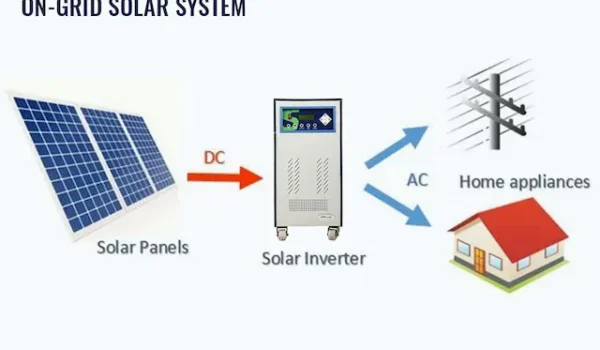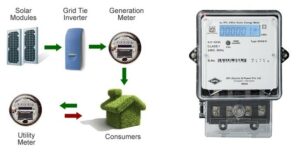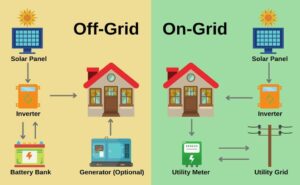On-Grid Solar System

An on-grid solar system also known as grid tie or connected solar system is the most cost effective type for solar system. It is a complete solar setup that comes with highly efficient solar panels, on-grid solar inverter and other standard solar accessories. This system will not only provides you continuous electricity but will also reduce your heavy electricity bills.
In this solar system, solar panels will generate the DC electricity by absorbing sunlight and the solar inverter will convert the same DC electricity into AC electricity which can then be used directly at home or business.
If the system will produce more power than is being consumed, the surplus is fed into the main electrical grid via solar net metering. At the time of electricity billing government or power provider company will adjust the exported units in your electricity bill.
There are various capacites of on-grid solar system available in the market. Therefore, you must read the complete below given information so that you can choose the best capacity that meets your power requirements.
How Does An On-Grid Solar System Work?
In an on-grid solar system, the array of solar panels are connected with the solar inverter, which is connected to the grid through your electricity meter. The solar panel converts sunlight into DC electricity which is then converted into alternating current better known as AC power. This AC power is the standard electrical current used for powering most home appliances and luxuries throughout the world.
- During the day, if the solar system’s production exceeds the house’s electrical needs, the excess electricity is automatically fed into the power grid via “Net-Metering”. When this occurs, you can observe the electrical meter spin backward.
- At night or anytime a household is using more electricity than the solar system is producing, the extra energy needed to power the house is pulled from the grid as it normally would be.
- Net metering is a process that analyzes and displays your grid exports and imports, like how much power is generated by solar, how much we consumed, and how much exported to the grid. Your electricity bill will be calculated on above said parameters.
- Solar net metering system explained in India : All these procedures are performed by a bi-directional meter. This tracking meter will keep tracking of a home’s total electrical consumption. You can easily track how much of your home’s electricity needs are being met by your system’s production and how well your system is performing at any point in time.
What is Solar Net Metering and How it Works :
In Solar Net Metering excess electricity is fed into our electric utility’s/electricity board when our On-Grid or Hybrid Solar Power Plant produces more than our need, in that case our meter runs in reverse direction. When our system is not producing enough electricity as per our load, then we can draw it from your utility just like ordinary meter. Solar panels produce peak electricity in the afternoon, when many people aren’t home in peak times may be in offices. In home electricity use is typically higher in the evenings and mornings, then net metering helps you to reduce electricity bill by using Import and export Facilities.
The existing energy meter in our building or home will need to be replaced by a two-way (bidirectional) meter. This bidirectional energy meter or Net Meter is essential as it can measure both, energy import (from the grid to the Customer) and energy export (from the customer to the grid) separately.

Pros & Cons of On Grid Solar :
Pros – Advantages :-
- Less cost compare to other types of solar system.
- Save your electricity bill up to 100%.
- Up to 40% government subsidy on solar.
- Utilities the 100% solar power produced by solar panel.
- Export the surplus solar power to electricity grid.
- No limitation of load, run all connected load with grid sharing.
- No battery bank, no recurring cost.
- ROI in 3-5 years, life 25-30 years.
Cons – disadvantages :-
- Works only with electricity grid, if electricity gone system will automatically shut down.
- No power backup, as there is no battery.
- On-Grid Solar System Installations In India
On-Grid Solar System Installations In India :
We have installed on-grid solar systems. Now people are enjoying comfortably in their homes even without grid electricity.
On-Grid Solar System Facts :
- The average generation capacity of a 1kW on-grid solar system is 4 units/day.
- 4 units x 30 days = 120 units/month &,
- 120 units x 12 months = 1,440 units/year.
- There is a 5 years warranty for the complete system and 25 years for the solar panel.
- Solar Net Metering applies on this system.
- MNRE (Ministry of New & Renewable Energy) is providing up to 40%subsidy on solar for on-grid solar systems.
Subsidy on On-Grid Solar System :
To promote solar power and to bring India ahead in the field of solar, the government is giving huge subsidy on solar. You can also take advantage of this subsidy scheme by installing an on grid solar system. The subsidy rates are:
- 1kW Solar System – 3kW Solar System = 40% Subsidy.
- 4kW Solar System – 10kW Solar System = 20% Subsidy
These subsidy rates may vary as per your state solar policy. Contact your state nodal agency for more info.

- What is on grid solar power system?
An on grid system is grid based solar system which connects to the utility grid. With this solar system, you can export excess power to the government grid. - What is net metering?
Solar net metering is a system which allows you to export excess solar electricity into the utility grid. By exporting power to the grid, you can reduce your electricity bill. Government will adjust it in your upcoming bills. - At which rate government will adjust the exported electricity?Government will not pay you in cash. There is a process of adjustment. When you export electricity into grid through net metering, your meter start to run inversely. And the units in your meter that you have already consume, starts to reduce.
